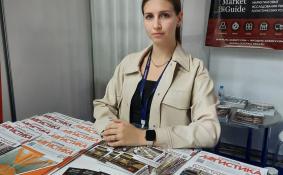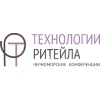
научно-практический
журнал

Новости редакции
18 ноября Президент Российского Союза химиков Виктор Иванов лично вручил директору «Агентства Маркет Гайд» и издателю журнала «ЛОГИСТИКА» Юлии Кисловой сертификат, подтверждающий членство агентства в Российском Союзе химиков.
Дорогие читатели! Десятый номер журнала «Логистика» открывается большим материалом, посвященным итогам Делового форума БРИКС, прошедшем 18 октября 2024 г. в Москве. Директор ООО «Агентство Маркет Гайд» и издатель журнала «ЛОГИСТИКА» Юлия Кислова побывала на мероприятии и подготовила статью, где особое внимание уделила международной торговле и логистической связанности стран объединения. Подробности – в номере.
Директор ООО «Агентство Маркет Гайд» и издатель журнала «ЛОГИСТИКА» Юлия Кислова посетила форум «Международный день торговли – 2024», который прошел 7 ноября 2024 г. в Москве, в Торгово-промышленной палате Российской Федерации. Основной темой форума стало международное сотрудничество и межрегиональная кооперация. Организатором форума выступила Ассоциация экспортеров и импортеров.
Статья недели:

ФОТО НЕДЕЛИ
ЦИТАТЫ
События в российской логистике
Food and beverage accounts for only 4-5% of total GLA in Moscow and St. Petersburg shopping centres
JLL presents the results of dining market research
MOSCOW, 17 November, 2016 – As retail market leaders discuss new market trends and challenges at MAPIC annual exhibition in Cannes, JLL reveals the results of the ‘Food & beverage (F&B) in Moscow and St. Petersburg shopping centres’ report.
A rising share of F&B shopping centres has become a global trend, which is clearly observed on the European market. According to JLL, food in European shopping centres averages 15% of the total GLA and is a crucial anchor in the tenant mix. Understanding the importance of the dining trend, landlords give preferences to F&B tenants. There are still few shopping malls in Russia where the dining area is recognized as a destination. Although there are some examples which fit the global trend.
“The overall supply of quality shopping centres in Russia has doubled over the last five years, exceeding 20m sq m . In 2015, 1.9m sq m was added, and similar volume is expected in 2016,” – Maria Shpakova, Senior Retail Market Analyst, JLL, Russia & CIS, comments. – “Such high volume of new retail space provides consumers with more choices. Their preferences also evolve. During the acute phase of the current recession, consumers have had to cut their spending and adjust shopping habits. As a result, competition between shopping centres for a loyal customer has become more intense. Well-organized dining area has become one of the ways to attract more people.”
Moscow is ahead of other European capitals by the total shopping centre supply, with 4.9m sq m of quality retail space in 104 shopping centres, while the total retail stock in St. Petersburg is 2.2m sq m in 58 malls. According to JLL estimates, the average F&B share in total GLA of Moscow shopping centres is about 4%. However, in some Moscow malls it is well above this level and close to the European average. In St. Petersburg shopping centres, the average F&B share is slightly higher than in Moscow, at 5%, as there are fewer large centres in the city.
The largest F&B shares in Moscow are in Evropeysky (15.4%), AFIMALL City (10.9%), Atrium (10.7%), and Okhotny Ryad (10.3%). The largest number of F&B units is in Evropeysky (67 units), Aviapark (60), and AFIMall City (51).
Nevsky Centre has the highest density of foodservice units among St. Petersburg shopping centres (12.5%). Other malls with large F&B shares are Galeria (9.5%), and Grand Kanyon (7.7%). The largest number of food concepts among St. Petersburg shopping centres is in Galeria (34), Leto (31), Grand Kanyon (28) and Piter Raduga (27).
“Apart from the F&B space allocation, another ingredient of a successful F&B offer in a shopping mall is diversity. A broad range of operators helps to attract more customers. A combination of brands with high awareness and new interesting local concepts can boost the operational performance of a shopping centre. In particular, landlords need to pay attention to unique, one-of-a-kind food concepts which can become attraction points.” – Tatyana Malyanova, Head of Shopping Centres Agency, JLL, Russia & CIS, notes.
There are five typical food service categories in a shopping centre, Casual Dining, Café, Fast Food, Impulse Kiosks, and Gourmet Food.
The Fast Food category in Russia is the only one comparable with Europe in its share in the total F&B space (about 30%). The shares of other categories divert from the European levels: the share of Casual Dining in Russia exceeds 50% of total F&B supply vs 35% in Europe. The Café category is relatively undersupplied in Russia compared to Europe: its share in St. Petresburg malls is 15%, in Moscow – 10%, while in Europe it accounts for 25%. The dominance of a single category in Russia indicates a limited variety.
“Most Russian shopping centres have standard food offers, which does not serve as an anchor and attraction point. Still, there are examples of well-organized, attractive concepts with a modern design and a unique variety of food operators.” – Maria Shpakova says. – “For example, in Moscow, some newly constructed malls provide visitors with trendy F&B areas, and a few older malls are in the process of F&B refurbishment. Russian shopping centres follow the global tendency of paying more attention to F&B by allocating larger areas and diversifying F&B offers. We also see that the F&B share in most successful and popular malls in Moscow and St. Petersburg are higher than the market averages. Developing a unique F&B offer attracts more consumers, supports tenant turnover, rental payments and capital values. Careful selection of food concepts enhances the overall attraction of a shopping mall and boosts its competitiveness in the current market.”











